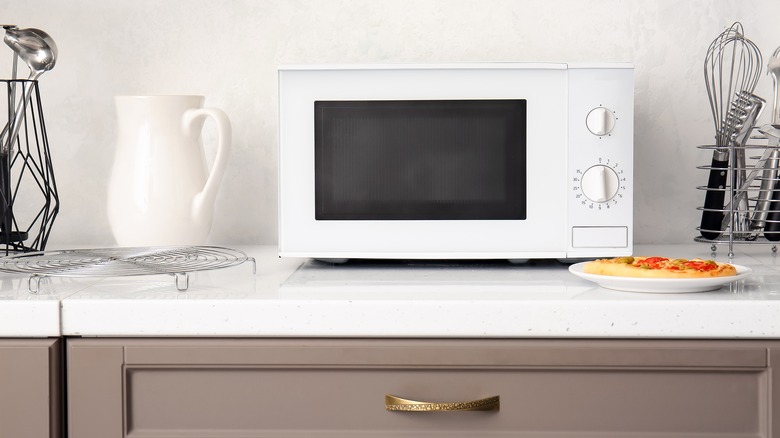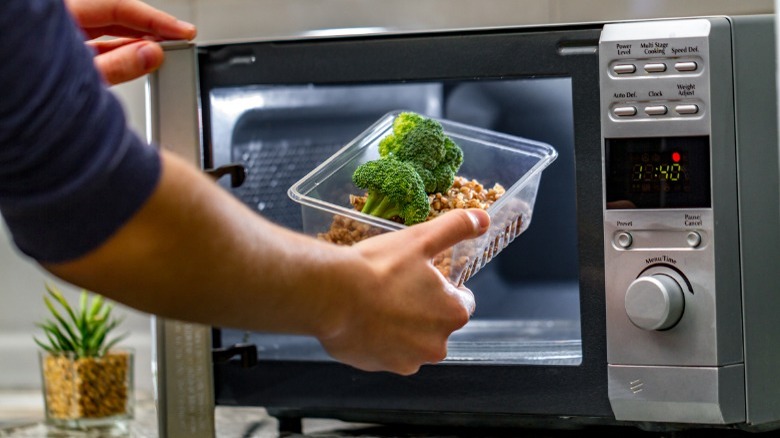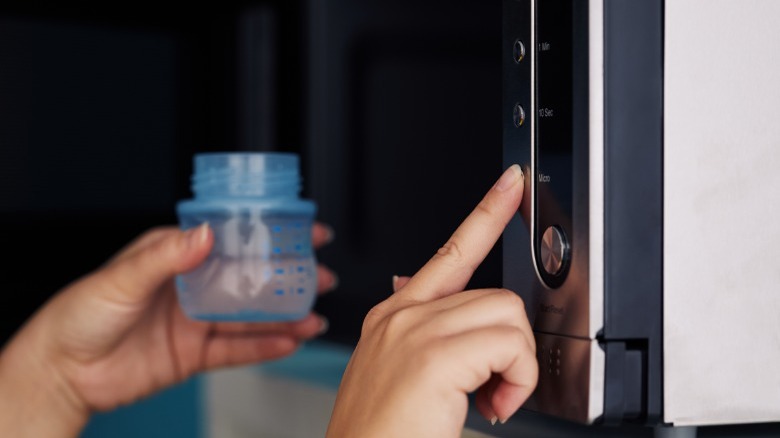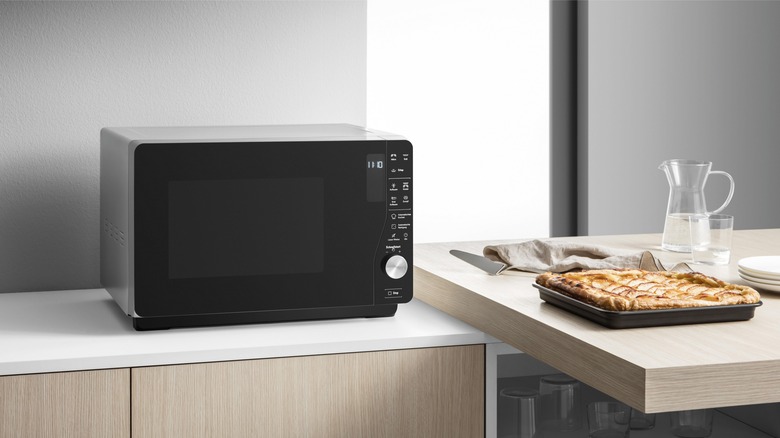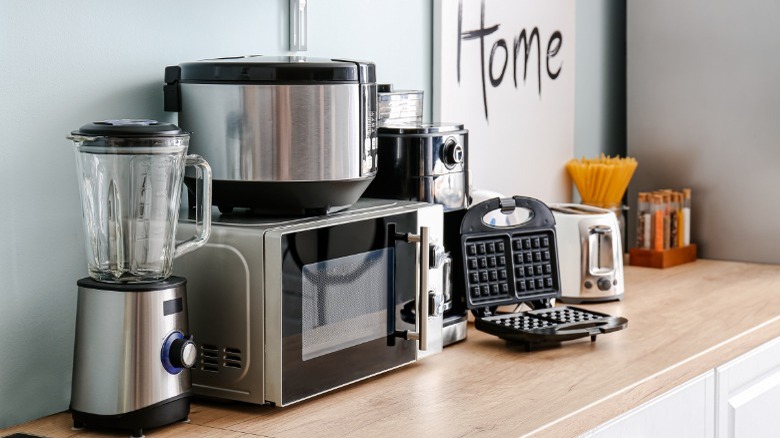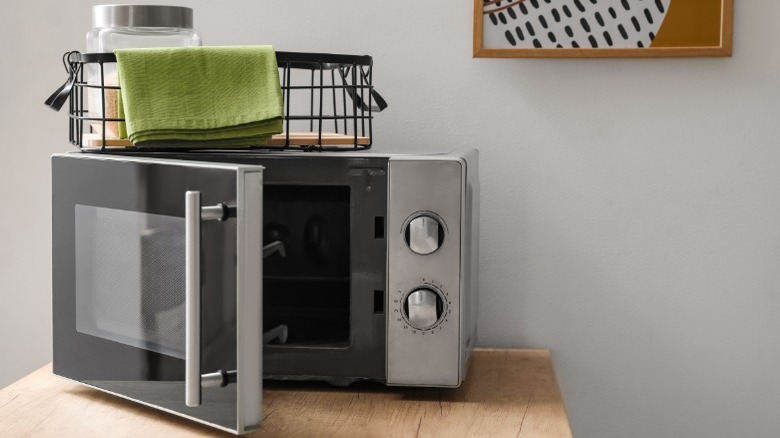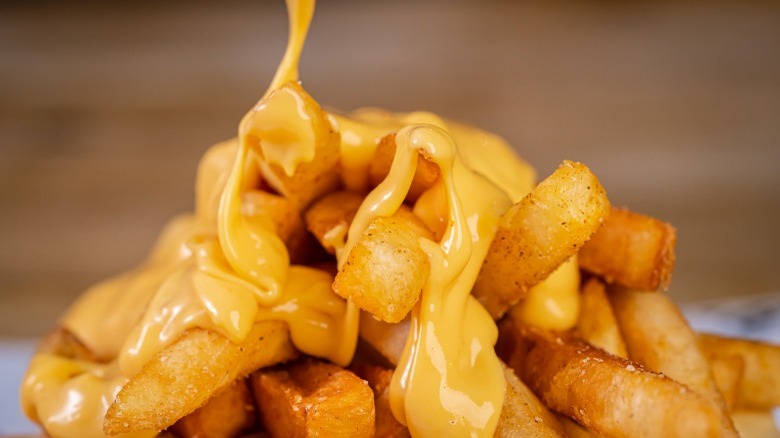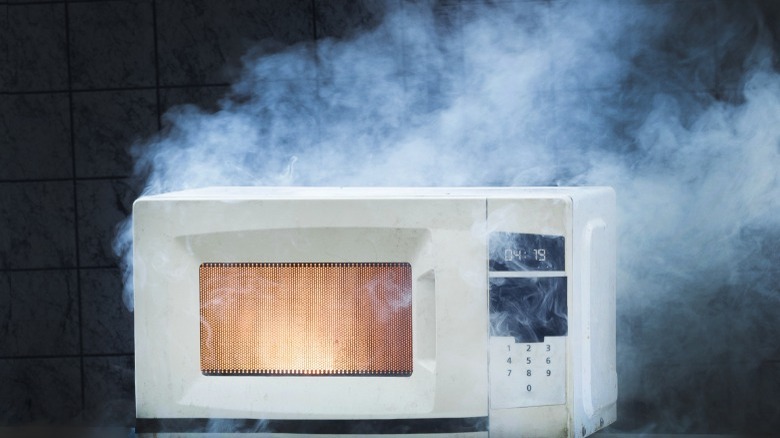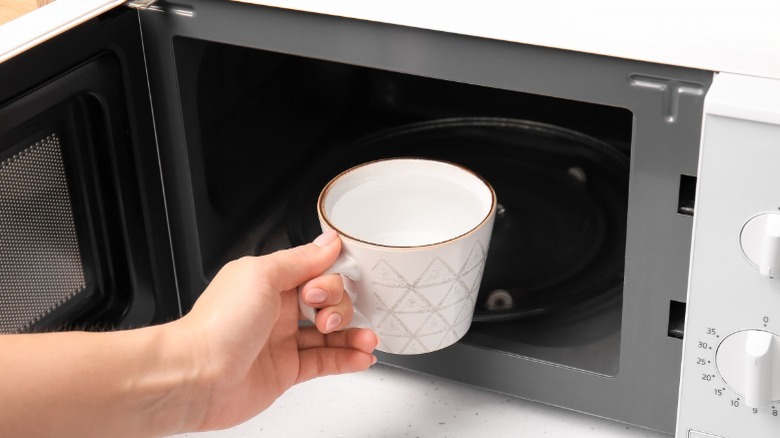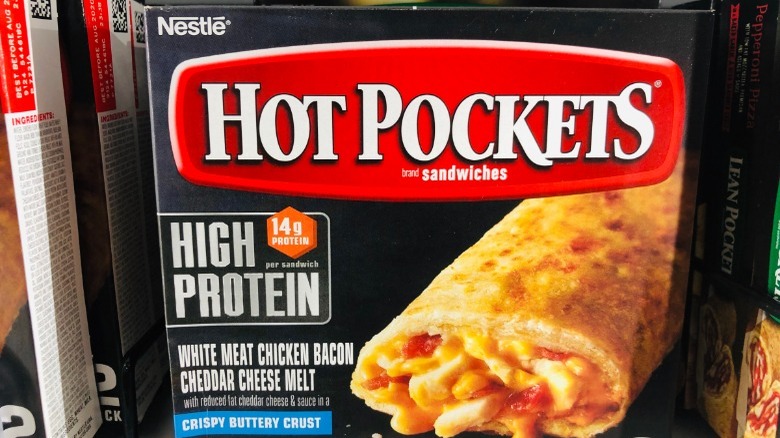The Hidden Downsides To Microwaves
The microwave is an amazing invention, and we use it every day. According to Everyday Health, it's estimated that in the United States, 90% of households have one or more microwaves. But like with most appliances, there are pros and cons to them. Some people believe that they can cause potential harm, like emitting radiation, increasing cancer risks, or zapping food of nutrients, but these myths have been proven untrue (via Grow). However, even though radiation may not pose any serious health risks to nukers, there are still some significant hidden downsides to microwaves. Since most of us use them all the time, it's important to know the facts from the fiction. Let's start by discussing a little bit about how they work.
Microwaves work using a non-ionizing form of electromagnetic radiation, per the FDA. This form of radiation does not have the power to alter atoms like harmful ionizing radiation. It heats food and liquids by making the water molecules in them vibrate, causing friction and heat. These "micro-waves" can penetrate glass, plastic, paper, etc. but are deflected by metals. As you can see, this is a very different way of cooking food than the ways we're used to. It's convenient and fast, but is it safe? Here are some of the dangers and warnings.
Plastic containers can leach harmful chemicals
According to Scienceline, it's not recommended to put plastic containers of any kind in the microwave since the plastic breaks down under intense heat. When it breaks down, it leaches chemicals into food that interfere with human hormones and cause health issues. These chemicals are things like BPA and phthalates, which are known to cause problems such as high blood pressure, kidney disorders, and heart issues.
Today, no one's exempt from this phenomenon. And the truth is, we don't know the long-term consequences. We can only limit our inevitable consumption of microplastics. Unfortunately, even products labeled microwave-safe can still leach chemicals; they just won't melt. While some microplastics will move through our bodies and eventually leave, others are absorbed, as new studies prove. According to a paper published in Environment International, microplastics were found in approximately 77% of human blood samples. These findings show it's important to use caution when consuming anything from plastic containers, although it's stressed that more studies need to be done to determine the level of potential danger. Knowing what we do know is enough to say putting plastic in the microwave is not a good idea.
It's harmful for heating breast milk or formula
Another caution is not to heat breast milk or baby formula in the microwave, per the FDA. There are many things to remember that can seem overwhelming to keep your baby safe. But when it comes to heating up either breast milk or formula, the microwave should be avoided. Mainly, this is due to the way the appliance heats things. There can be hotspots in the liquid that can burn the baby's mouth and throat, even if it doesn't seem too hot when you test it on your hand. In fact, heating solid baby food in the microwave is also cautioned against, especially in jars.
Also, specifically concerning breast milk, the microwave can break down its nutritional value due to its concentrated high heat (via The Baby's Brew). Since most mothers are breastfeeding due to the proteins and enzymes, it would be counterproductive to warm the milk using a microwave. There are better ways to do this that don't take much extra time.
They don't always kill bacteria
Because of the way microwaves cook food, they don't actually kill bacteria, per Hygiene Food Safety. If anything, they can leave cold spots in the middle where bacteria can survive. Microwaves do not cook food from the inside out, as many people think. They actually cook from the outside in. They rely on the inside of the food being cooked by superheating the molecules on the outside, sort of like a chain reaction. It works, but not always as well as we'd hoped, sometimes leading to bouts of food poisoning.
Studies have shown that E.coli and salmonella can indeed survive in the microwave. Usually, heating food to the proper temperature kills these bacteria. The problem with microwaves occurs mostly when cooking food with different shapes and thicknesses. Think of a piece of meat, for example — one side might be much thicker than the other. This results in spots that may not reach a high enough temperature to kill all the potentially harmful bacteria. So don't make the common mistake of thinking your food is being automatically disinfected when you cook it in the microwave.
They need to be vented
You may not be aware that microwaves need ventilation (via KitchenCuddle). As we've explained, microwaves cook food by superheating molecules inside until they vibrate rapidly, causing friction and thus heat. The heat expands inside the oven while this happens, which is why it's equipped with vents. The heat is released, ensuring there isn't too much pressure in the appliance. When installing a microwave in your kitchen, it's important to leave space between these vents and anything else. The instruction manual will tell you how much clearance space to allow for these vents, and it's important to follow this step.
According to HVACSeer, microwaves with so-called built-in venting systems are inadequate and still require external space to function properly. If the vents are blocked, the results could be catastrophic, such as experiencing fires or explosions. Putting anything on top of the appliance that could hang over and block the vents can be dangerous, too. Blocked or limited space around the microwave can cause overheating or a malfunction, so be sure they're vented and have plenty of space around them.
Dries out food
The microwave is not ideal for cooking all types of food, and one of the main reasons is it tends to dry things out (via GE Appliances). If you've ever cooked a meal in the microwave, you know that sometimes food can dry out and be cooked unevenly. Meat can be tough and flavorless, rice can become dry, and pasta can become gummy. These are all trademarks of cooking in the microwave. Even though most of us have experienced this for ourselves, we still use the appliance faithfully. One problem is all microwaves are not the same. Different sizes, wattages, and whether it has a rotating carousel are three big factors that can give varying results.
The instructions on a package will often have different times listed for different microwave wattages. Be sure you know the specific wattage for the one you have, and pay attention to this. Cooking anything for longer than required will dry it out and tend to make the meat tough. But not cooking food long enough can result in undercooking. Be sure you follow all instructions and steps exactly for your model, and allow some standing time to finish cooking. Make sure you also pay attention to the power level, as certain things will have different times on different power levels. Mastering your microwave will take some trial and error, and it's not ideal for everything.
Don't try to deep fry in them
According to GE Appliances, it does not recommend, in any way, shape, or form, attempting to deep fry any food in the microwave. Although it's technically possible, there are just too many things that could go terribly wrong. Hot oil is a dangerous thing to play around with, and putting food in and out of a container in your microwave just isn't smart. Additionally, it's messy and difficult! Aside from that, there's really no container ideal for deep frying in a microwave, as none of the things you might normally be able to use will withstand the extreme temperatures for the extended time needed. That's right, even Pyrex or Fire King, although tempered, may not be enough.
In fact, some of these containers can explode under the extreme and prolonged heat necessary for a microwave to handle this task. In addition to that, the potential danger hot oil poses a serious burn risk. We've all experienced deep frying something in hot oil and getting stung by the popping and hissing of errant drops hopping in and outside of the pan, or even the deep fryer. The same thing can happen if you try to deep fry food in the microwave, so, to put it simply? Don't.
It can catch on fire
According to Wirecutter, there are several ways your microwave could catch on fire, but most relate to overheating the food inside. Packaging can also get stuck too close to the wave emitter in some cases. Luckily, most modern microwaves are UL-certified and therefore designed to contain these types of fires, so all you would need to do is turn the power off and keep the door closed. It's also noted that sparks are generally safe and don't always mean fire inside the microwave.
Other causes for microwave fires can be things like power surges that may fool the appliance into turning on and staying on. If you're not particularly observant that day, or perhaps you're busy changing diapers or outside watering plants, it could go unnoticed and start a fire. Another cause could be the power supply shorting out, which can burn the electrical work inside. It's important to keep the microwave from overheating; some models may be more prone to this than others. Always use it with caution, and don't leave it running for extended periods of time while out of the room.
Overheating water can pose serious burn risk
A serious risk is associated with overheating liquids (or foods) in the microwave and receiving burns in return (via the FDA). The main problem is with overheating water past its boiling point. While water will boil in a kettle or pot, it will stay deceptively calm in a microwave. When this happens, the results can be extremely dangerous because when you disturb the deceptively calm surface, it can erupt like a volcano and cause severe burns. Unfortunately, this can happen just as easily from emptying a package of hot cocoa into the water or simply moving it too fast. This phenomenon has happened to many people.
When using a microwave to heat water, use extra caution because although it's not bubbling as we're accustomed to, that doesn't mean it hasn't reached the boiling point. Once you know how long it takes to get to the temperature you prefer, try not to put it in any longer than that. This risk is further reduced by putting in your cocoa (or whatever) first, as it's mostly only water by itself that does this. Just remember it might not look dangerously scalding hot, but it very likely is.
Putting metal in them can be dangerous
As you probably are already fully aware, putting metal in the microwave is a no-no, per Wired. The radiation waves do not penetrate metal but are deflected by it, as previously mentioned. Results may vary depending on what kind of metal you put in, but they're rarely ever good. At a minimum, harmless sparks could erupt. At maximum, a fire or explosion could occur. The thinner or more pointy edges the metal contains, the more extreme the reaction might be. Even just forgetting and putting in one of your antique teacups with silver or gold edges can result in a lively firework show inside your microwave.
God forbid there's anything flammable in there with the metal, because that can start a fire. Sometimes the metal will become extremely hot to the touch, so be careful when removing it from the microwave. You might be thinking, what about Hot Pockets? They have a metal lining inside that's microwaveable, don't they? Yes, but it's specially designed to bounce the waves inward, toward the food inside the pocket. Also, smooth metal or heavier metal is not as dangerous. To be safe, refrain from leaving the spoon inside or the aluminum foil around the edges when you place the dish in the microwave.
